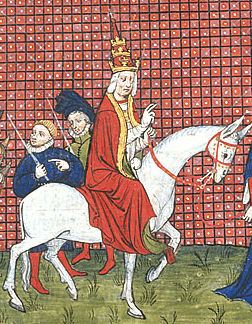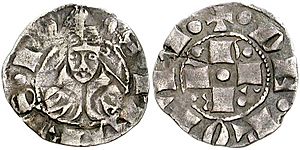Pope Gregory XI facts for kids
Quick facts for kids Pope Gregory XI |
|
|---|---|
| Bishop of Rome | |

Gregory XI entering the Palace of the Popes, Avignon
|
|
| Church | Catholic Church |
| Papacy began | 30 December 1370 |
| Papacy ended | 27 March 1378 |
| Predecessor | Urban V |
| Successor | Urban VI |
| Orders | |
| Ordination | 2 January 1371 |
| Consecration | 3 January 1371 by Guy of Boulogne |
| Created Cardinal | 29 May 1348 |
| Personal details | |
| Birth name | Pierre Roger de Beaufort |
| Born | c. 1329 Maumont, Limousin, Kingdom of France |
| Died | 27 March 1378 (aged 48–49) Rome, Papal States |
| Other Popes named Gregory | |
Pope Gregory XI (born Pierre Roger de Beaufort; c. 1329 – 27 March 1378) was the leader of the Catholic Church from 1370 until his death in 1378. He was the seventh and last Avignon pope. This means he was the last pope to live in Avignon, France, instead of Rome. In 1377, Gregory XI moved the Pope's home back to Rome. This ended nearly 70 years of popes living in Avignon. His death soon after led to a big split in the Church called the Western Schism.
Contents
Early Life
Pierre Roger de Beaufort was born in Maumont, France, around 1330. His uncle, Pierre Cardinal Roger, became Pope Clement VI in 1342. Pope Clement VI gave his nephew many special church positions. In 1348, when Pierre was only eighteen, his uncle made him a cardinal deacon. Pierre studied at the University of Perugia. There, he became an expert in church law and religious studies.
Becoming Pope
After Pope Urban V died in December 1370, eighteen cardinals met in Avignon. This meeting, called a conclave, was to choose the next pope. Cardinal Roger was chosen by everyone on December 30. At first, he didn't want to be pope, but he finally accepted. He took the name Gregory XI. On January 4, 1371, he became a priest. The next day, he was made Bishop of Rome and crowned in Avignon.
Leading the Church
Right after becoming Pope, Gregory XI tried to make peace between the Kings of France and England. However, he was not successful. He did help create a lasting peace between the kingdoms of Sicily and Naples in 1372. Both of these kingdoms were under the Pope's influence.
Working for Peace
Gregory also wanted to start a new crusade. He was encouraged by Catherine of Siena, a holy woman. He continued Pope Urban V's call for Christians to stop fighting each other. Gregory also worked to fix bad practices in different religious groups. For example, some groups were charging money to visit holy places. Others were showing fake holy objects. Catherine of Siena often wrote letters to Gregory, pushing him to make these changes.
Challenges in Italy
Like the popes before him in Avignon, Gregory XI made a mistake. He appointed French people to lead church areas in Italy. These French leaders did not understand the Italians, and the Italians did not like them. Italian cities did not want the Pope to move back to Rome. Florence, in particular, was against it. This was because Gregory wanted to expand the Papal States (lands controlled by the Pope) when he returned.
Before moving to Rome, Gregory had to deal with problems in Italy. Duke Bernabo Visconti of Milan took control of Reggio and other places in 1371. These places were supposed to be loyal to the Pope. Gregory XI removed him from the church and later started a war against him in 1372. Florence led a group of Italian cities against the Pope. This war became known as the War of the Eight Saints (1375-1378).
After the war began, Gregory removed Florence from the church. He also banned church services in the city in March 1376. This was an attempt to stop the rebellion. Catherine of Siena tried to convince Gregory to end the war for Florence. But her efforts did not work. The war continued until after Gregory's death. A peace treaty was finally signed in July 1378 by the next Pope, Pope Urban VI.
Moving Back to Rome
Moving the papacy back to Rome from Avignon had been a big discussion since 1309. For 68 years, popes had ruled from France. They all had reasons to stay there. But in 1377, Gregory XI finally moved the Pope's home back to Rome.
Why Return to Rome?
Catherine of Siena sent many letters to Gregory XI. She wrote 14 letters between 1375 and 1378. These letters talked about peace, church reform, and moving the Pope back to Rome. Catherine told him that it would be easier to achieve peace among Italian cities if the Pope was in Rome. She also believed that church reform would be more likely if the Pope was back in Rome.
The Journey Home
The journey to move the Pope's administration back to Rome began on September 13, 1376. Many French cardinals and the French king protested. But Gregory left Avignon that day. He traveled to Marseilles and boarded a ship on October 2. He arrived in Corneto on December 6. He stayed there to make plans for the government in Rome. On January 13, 1377, he left Corneto. He landed at Ostia the next day and sailed up the Tiber River. On January 17, he made a grand entrance into Rome.
Death and Its Impact
Gregory XI did not live much longer after moving to Rome. He died on March 27, 1378, at about 48 or 49 years old. After his death, an Italian, Pope Urban VI, was chosen as the next pope. However, Gregory's decision to move the papacy back to Rome led to the Western Schism. This was a time when there were two or even three people claiming to be the true Pope. Most of Europe supported Clement VII, who is now considered an "antipope" (someone who falsely claims to be Pope).
Even though the papacy was back in Rome, it took another century of popes working hard to make the Church strong again. The Western Schism was finally resolved at the Council of Constance (1414–1418).
See also
 In Spanish: Gregorio XI para niños
In Spanish: Gregorio XI para niños



